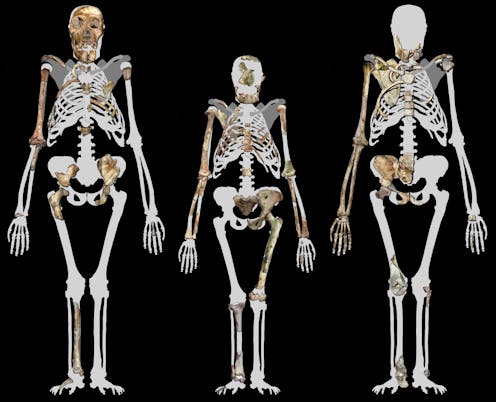When and how was walking invented?
- Written by Jan Simek, Professor of Anthropology, University of Tennessee

Lucy had a partial but well-preserved pelvis, which was how anthropologists knew she was female. The pelvis and upper leg bones fit together in a way that showed she walked upright on two legs[8]. No feet bones were preserved, but later discoveries of A. afarensis do include feet and indicate bipedal walking as well.
In addition to fossil remains, scientists found other remarkable evidence[9] for how Lucy’s species moved at the Laetoli site in Tanzania. Beneath a layer of volcanic ash dating to 3.6 million years ago, anthropologists found fossilized footprints in what had once been a wet surface of volcanic ash. The tracks go along for almost 100 feet, and 70 individual prints indicate the presence of at least three individuals walking upright on two feet. Given the presumed age, the makers were likely Australopithecus afarensis.
The tracks prove that these hominins walked on two legs, but the gait seems to be a bit different from ours today. Still, Laetoli provides solid evidence for bipedalism[10] 3.5 million years ago.
A hominin whose anatomy was so like our own that we can say it walked as we do did not appear in Africa until 1.8 million years ago. Homo erectus was the first to have the long legs and shorter arms that would have made it possible to walk, run and move about Earth’s landscapes as we do today[11]. Homo erectus also had a much larger brain than did earlier bipedal hominins and made and used stone tools called Acheulean implements[12]. Anthropologists consider Homo erectus our close relative and an early member of our own genus, Homo.
So, as you can see, human walking took a very long time to develop. It appeared in Africa more than 4.4 million years ago, long before tool-making appeared.
Why did hominins walk upright? Perhaps it allowed them to see predators more easily, or to run faster, or maybe the environment changed and there were fewer trees to climb as earlier hominins did.
In any case, humans and their ancestors began to walk very early in their evolutionary history. Even though bipedalism came before tool-making, an upright posture freed the hands to make and use tools, which ultimately became one of the hallmarks of humans like us.
Hello, curious kids! Do you have a question you’d like an expert to answer? Ask an adult to send your question to CuriousKidsUS@theconversation.com[13]. Please tell us your name, age and the city where you live.
And since curiosity has no age limit – adults, let us know what you’re wondering, too. We won’t be able to answer every question, but we will do our best.
References
- ^ CuriousKidsUS@theconversation.com (theconversation.com)
- ^ many millions of years ago (www.smithsonianmag.com)
- ^ 4.2 million and 4.4 million years old (humanorigins.si.edu)
- ^ as early as 4.4 million years ago (doi.org)
- ^ a million years after Ardi (www.nationalgeographic.org)
- ^ Smithsonian (media.nationalgeographic.org)
- ^ CC BY-SA (creativecommons.org)
- ^ she walked upright on two legs (www.nhm.ac.uk)
- ^ other remarkable evidence (doi.org)
- ^ solid evidence for bipedalism (humanorigins.si.edu)
- ^ move about Earth’s landscapes as we do today (humanorigins.si.edu)
- ^ called Acheulean implements (www.thoughtco.com)
- ^ CuriousKidsUS@theconversation.com (theconversation.com)
Authors: Jan Simek, Professor of Anthropology, University of Tennessee
Read more https://theconversation.com/when-and-how-was-walking-invented-165516

